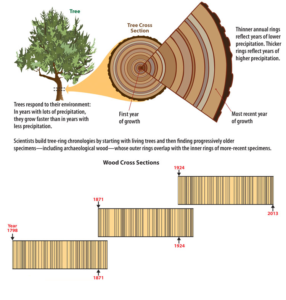Tree-Ring Dating
Dr. Rubén G. Mendoza, PhD
Introduction: Dendrochronology, or Tree Ring Dating, is a method pioneered at the University of Arizona for the purposes of assessing meteorological or weather-related patterns and data over long spans of time. Shortly after its development, Dendrochronology was applied to the interpretation of ancient timbers from Ancestral Pueblo Indian sites in Arizona and the greater Southwest. Today, the Dendrochronology Lab at the University of Arizona maintains a master tree ring chronology amenable to archaeological and meteorological applications from throughout the US Southwest.
Deliverables: The outcomes and deliverables sought from this exercise require that you acquire a basic working knowledge of how Dendrochronology dates are obtained. In this instance, you will have the opportunity to work an increment coring tool, and will in turn assess the absolute and relative dates of trees on the project site, or on CSU Monterey Bay campus.
Instructions: The following considerations and procedures should be taken into account when obtaining (a) increment cores from local trees, (b) creating a mini-master tree-ring index for said trees, and (c) assessing the start and end dates for said trees:
1. First, your Dendrochronology team should select three local trees from which to obtain core samples. You should then prioritize the trees so that key samples are obtained within the allotted time frame. So as to obtain samples that provide the largest consecutive collection of tree rings, the largest available tree should be considered your first priority.
2. Second, assemble the Suunto Increment Corer if it has not already been assembled. Assembly requires that a standard screwdriver is used to loosen the latch plate to the device. Then, you will need to unscrew the large gnarled knob at the end of the Increment Corer. Carefully remove the metal tubes contained therein. Assemble the device as instructed by your professor. The following basic procedure should then guide sample collection:
§ Position the increment corer diagonal to the face of a lower portion of the tree selected for sampling.
§ Aim the tip of the coring device at the midpoint or center of the tree such that it would appear that you are targeting the very midpoint of the tree’s core.
§ Firmly, but steadily, turn the handle in a clockwise direction until the core element or screw-like tip burrows into the bark of the tree.
§ Having started the coring process, continue to turn the handle in a clockwise direction until the coring tool has penetrated the tree to the maximum extent possible.
§ Now, reverse the direction on the increment corer and gradually extract the device.
§ Upon removing the increment corer from the girth of the tree, now extract the core via the slender tube contained at the heart of the coring drill.
§ Place the core sample in the increment core sample tray provided for that purpose.
§ Finally, apply a dye or tree-ring staining solution to enhance detection of rings in each specimen.
3. Third, having extracted and treated your samples, now compare and align the tree rings in your samples in such a way that corresponding rings (both narrow and wide) align one with the other. Using this information, and the cutting date, or final date related to the cambium or outermost layer of the tree, interpret the relative ages of the trees samples.


